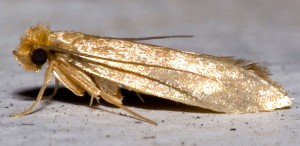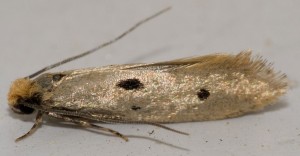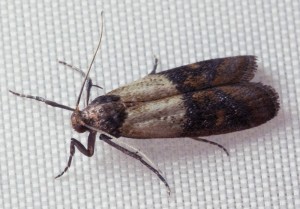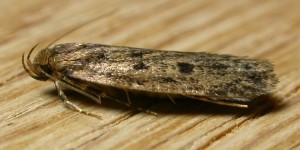If you discover moths in your home, it is usually one of the following species:
- Clothes moth
- Case-bearing clothes moths
- Indian meal moths
- Brown house moths
Below you can read more about these 4 species and their occurrence and behavioral patterns in the home.
Clothes moth
Food: Clothes moth larvae feed mainly on organic textiles such as wool, silk, feathers, etc. In practice, clothes moth larvae often attack old clothes or other textiles. Note that clothes moths can only survive in the home and not in the wild.
Signs: If you find clothes with holes in them, which may also be soiled with small white droppings and webs (from the larvae), it could very well be due to clothes moths. Note, however, that both case-bearing clothes moths and brown house moths can also pierce clothing and other textiles.
Control: Clothing moth control involves 1) thoroughly inspecting all textiles for larvae and eggs, 2) cleaning all textiles and storage areas and 3) storing all textiles in well-sealed bags. More detailed instructions can be found via the link below.
Read more about clothes moths here.
Case-bearing clothes moth
Food: Fur moth larvae feed on organic textiles like clothes moth larvae, but in rare cases can also feed on dry foods. Fur moth larvae mainly attack fur, but can also feed on other types of textiles.
Signs: If you have a fur coat hanging in a closet and you notice that there are large furless patches (where the fur has “fallen off”), it is most likely due to Case-bearing clothes moths. Their larvae gnaw the fur hairs at the root and typically move around in a confined area, resulting in the furless patches.
Control: As with clothes moths, controlling case-bearing clothes moths involves inspecting all textiles in the home, cleaning them and their storage areas and preventing future infestations by storing all stored textiles in tightly sealed bags. More detailed instructions can be found via the link below.
Read more about case-bearing clothes moths here.
Indian meal moths
Food: In the home, indian meal moth larvae primarily feed on dry foods such as cereals, breakfast cereals, spices, bulgur, etc. However, they can also feed on various plant materials.
Signs: Larval webs in food or food that clumps together due to larvae defecation are two very typical signs of Indian meal moths. The larvae are usually difficult to spot. The adult moths are attracted to light and if you see them flying or running around, this is almost a sure sign of a moth infestation.
Control: To control indian meal moths, do three things; 1) inspect all foods, 2) discard all infested foods, 3) clean all kitchen cabinets and 4) prevent future infestations by storing all dry goods in airtight containers. More detailed instructions can be found via the link below.
Read more about indian meal moths here.
Brown house moths
Food: Brown house moths larvae have the largest food spectrum of all the moth species commonly found in the home. They can feed on organic materials, plant materials and some animal materials. However, in the home, brown house moths are often thought of as moths that attack clothing as they typically infest textiles.
Signs: If brown house moths have infested textiles, this is usually indicated by holes in clothing, which may also be accompanied by the larvae's web and excrement. If they occur in food, these are the same signs of the indian meal moths (see above).
Control: When brown house moths appear in the home, they may well originate from a bird's nest near the home. In some cases, it could also be an insect nest. Therefore, it is important to inspect your surroundings if you are infested with brown house moths. The rest of the control process is pretty much the same as if you have clothes moths/case-bearing clothes moths or indian meal moths (depending on whether it's textiles or food that is infested). More detailed instructions for brown house moths control can be found via the link below.
Read more about brown house moths here.
Moths in the cupboard
Moths are often divided into two groups, which also live in two different places:
- Clothes moths: Clothes moths often live in closets, drawers, basements, attics and other undisturbed places where there are stored organic textiles. If you have found one or more moths in a wardrobe, they are almost always clothes moths or case-bearing clothes moths.
- Food moths: In private households, food moths mainly feed on the dry foods found in e.g. kitchen cupboards. Moths prefer food in cupboards to shelves as they are more enclosed, dark and undisturbed. Most people also often keep food in their cupboards for months or years, which is ideal for moth breeding. If you find moths in your kitchen cupboard, they are most likely indian meal moths or brown house moths.
Moths in the house
It should be mentioned that some moth species (especially brown house moths) are generally more common in houses than in apartments. This is especially true if the house has a garden or is in the countryside, because these places are more likely to have bird nests, insect nests, carrion, dead insects and the like, which can be breeding grounds for moths.
Old houses are also usually more prone to moth infestation because there are more cracks, crevices, holes and the like, which moths prefer. Once moths have established themselves in the house, they can become a major problem.
Other species in the home
If you have discovered moths in your home and you don't think it's any of the above species, check out our extended overview of 12 moth species here.
You can also use the chart on our moth theme page to compare the different species.




